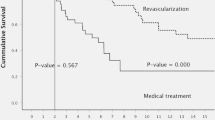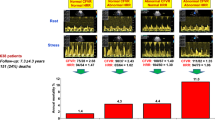Abstract
Stress-induced asynergies in the infarct area following thrombolytic therapy are considered to reflect incomplete recanalization of the culprit vessel. However, reperfusion is a dynamic process with successive pathophysiological phases, so that the timing of assessement of residual ischemia may have relevant clinical implications. We studied the time-course of dobutamine-induced homozonal asynergies in 61 (group B) survivors of uncomplicated infarction as compared to 54 (group A) control subjects showing normal response to dobutamine stress echocardiography within 10 days of acute myocardial infarction. The 79 (43 of group A and 36 of group B) patients not presenting new cardiac events underwent further dobutamine stress echo within 90 ± 17 days, which was positive in 20 and negative in 59. Persistence of test positivity was observed in just 17/36 (47%) patients, who showed significantly more extensive dobutamine-induced asynergies as compared to pre-discharge evaluation and less frequent (p<0.01) evidence of viable myocardium. These results arise question about the decisional impact of stress-induced wall motion abnormalities in the culprit vessel area early after thrombolysis in low-risk patients and emphasize the need to further clarify the time factor role in this setting.
Similar content being viewed by others
References
Berthe C, Pierard LA, Hiernaux M, Trotteur G, Lampereur P, Carlier J, Kulbertus HE. Predicting the extent and location of coronary artery disease in acute myocardial infarction by echocardiography during dobutamine infusion. Am J Cardiol 1986; 58: 1167–1172.
Bolognese L, Sarasso G, Aralda D, Bongo AS, Rossi L, Rossi P. High-dose dipyridamole echocardiography early after acute myocardial infarction: correlation with exercise stress testing and coronary angiography. J Am Coll Cardiol 1989; 14: 357–363.
Bolognese L, Sarasso G, Bongo AS, Rossi L, Aralda D, Piccinino C, Rossi P. Dipyridamole echocardiography test: a new tool for detecting jeopardized myocardium after thrombolytic therapy. Circulation 1991; 84: 1100–1106.
Picano E, Landi P, Bolognese L, Chiarandà G, Chiarella F, Seveso G, Sclavo Mg, Gandolfo N, Previtali M, Orlandini A, Margaria F, Pirelli S, Magaya O, Minardi G, Bianchi F, Marini C, Raciti M, Michelassi C, Severi S, Distante A on behalf of the EPIC Study Group. The prognostic value of dipyridamole-echocardiography early after uncomplicated myocardial infarction: a large scale multicenter trial. Am J Med 1993; 95: 608–618.
Sicari R, Picano E, Landi P, Pingitore A, Bigi R, Coletta C, Heyman Joanna, Casazza F, Previtali M, Mathias W Jr., Dodi C, Minardi G, Lowenstein J, Garyfallidis X, Cortigiani L, Morales MA, Raciti M, on Behalf of the Echo Dobutamine International Cooperative (EDIC) Study. Prognostic value of Dobutamine-atropine stress echocardiography early after acute myocardial infarction. J Am Coll Cardiol 1997; 29: 254–260.
Bigi R, Galati A, Curti GP, Coletta C, Partesana N, Bordi L, Barlera S, Ceci V, Occhi G, Fiorentini C. Prognostic value of residual ischemia assessed by means of exercise electrocardiography and dobutamine stress echocardiography after uncomplicated myocardial infarction. Eur Heart J 1997; 18: 1873–1881.
McNeill AJ, Fioretti PM, El-Said ME, Salustri A, Forster T, Roelandt JRTC. Enhanced sensitivity for detection of coronary artery disease by addition of atropine to dobutamine stress echocardiography. Am J Cardiol 1992; 70: 41–46.
Shiller NB, Shah PM, Crawford M, DeMaria A, Devereux R, Feigenbaum H, Gutsegell H, Reichek N, Sahn D, Schnittger I, Silverman NH, Taijik AJ. Recomendations for quantitation of left ventricle by two-dimensional echocardiography. J Am Soc Echocardiog 1989; 2: 358–367.
Brown BG, Gallery CA, Badger RS, Kennedy JW, Mathey D, Bolson E, Dodge HT. Incomplete lysis of thrombus in the moderate underlying atherosclerotic lesion during intracoronary infusion of streptokinase for acute myocardial infarction: quantitative angiographic observations. Circulation 1986; 73: 653–661.
Topol EJ, Califf RM, George BS, Kereiakes DJ, Abbottsmith CW, Candela RJ, Lee KL, Pitt B, Stack RS, O'Neill WW. A randomized trial of immediate vs delayed elective angioplasty after intravenous tissue plasminogen activator in acute myocardial infarction. New Eng J Med 1987; 317: 581–588.
Rogers WJ, Baim DS, Gore JM, Brown BG, Roberts R, Williams DO, Chesebro JH, Babb JD, Sheehan FH, Wackers FJTh, Zaret BL, Robertson TL, Passamani ER, Ross R, Knatterud GL, Braunwald E. Comparison of immediate invasive, delayed invasive, and conservative strategies after tissue-type plasminogen activator. Results of the Thrombolysis in Myocardial Infarction (TIMI) Phase-II-A Trial. Circulation 1990; 81: 1457–1476.
Krug A, deRochemond WM, Karb G. Blood supply of the myocardium after temporary coronary occlusion. Circ Res 1966; 19: 57–62.
Kloner RA, Ganote CE, Jennings RB. The 'no-reflow' phenomenon after temporary coronary occlusion in the dog. J Clin Invest 1974; 54: 1496–1508.
Ambrosio G, Weissman HF, Mannisi JA, Becker LC. Progressive impairment of regional myocardial perfusion after initial restoration of postischemic blood flow. Circulation 1989; 80: 1846–1861.
Ragosta M, Camarano G, Kaul S, Powers ER, Sarembock IJ, Gimple LW. Microvascular integrity indicates myocellular viability in patients with recent myocardial infarction: new insights using myocardial contrast echocardiography. Circulation 1994; 89: 2562–2569.
Manyani DE, Knudtson M, Roth D. Sequential thallium-201 myocardial perfusion studies after successful angioplasty: delayed resolution of exercise-induced scintigraphic abnormalities. Circulation 1988; 77: 86–95.
Uren NG, Crake T, Lefroy DC, DeSilva R, Davies GJ, Maseri A. Delayed recovery of coronary vessel function after coronary angioplasty. J Am Coll Cardiol 1993; 21: 612–621.
Ishihara M, Sato H, Tateishi H, Kawagoe T, Yoshimura M, Muraoka Y. Impaired coronary flow reserve immediately after coronary angioplasty in patients with acute myocardial infarrction. Br Heart J 1993; 69: 288–292.
Galli M, Marcassa C, Bolli R, Giannuzzi P, Temporelli PL, Imparato A, Silva Orrego PL, Giubbini R, Giordano A, Tavazzi L. Spontaneous delayed recovery of perfusion and contraction after the first 5 weeks after anterior infarction: evidence for the presence of hibernating myocardium in the infarcted area. Circulation 1994; 90: 1386–1397.
Carù B, Bossi M, Bonelli R, Colombo E, Pedretti R, Santoro F, Anza C, Maslowsky F, Laporta A. Functional evaluation 10 days and 3 weeks after acute myocardial infarction: comparative significance and prognostic value Eur heart J 1992; 13: 201–206.
Author information
Authors and Affiliations
Rights and permissions
About this article
Cite this article
Bigi, R., Curti, G., Sponzilli, C. et al. Time-course of dobutamine-induced wall motion abnormalities in the infarct area following thrombolytic therapy. Int J Cardiovasc Imaging 14, 381–384 (1998). https://doi.org/10.1023/A:1006028526024
Issue Date:
DOI: https://doi.org/10.1023/A:1006028526024




